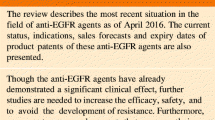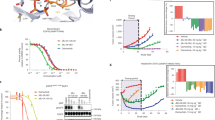Summary
PD153035 is a potent (Ki=6 pm) and specific inhibitor of the epidermal growth factor (EOF) receptor tyrosine kinase that suppresses tyrosine phosphorylation of the EGF receptor in A431 cells at nanomolar concentrations in cell culture. We have examined the pharmacokinetics of this compound and its ability to rapidly suppress phosphorylation of the EGF receptor in A431 human epidermoid tumors grown as xenografts in immunodeficient nude mice. Following a single i.p. dose of 80 mg/kg, the drug levels in the plasma and tumor rose to 50 and 22 μM within 15 minutes. While the plasma levels of PD153035 fell below 1 μM by 3 hours, in the tumors it remained at micromolar concentrations for at least 12 hours. The tyrosine phosphorylation of the EGF receptor was rapidly suppressed by 80–90% in the tumors. However receptor phosphorylation returned to control levels after 3 hours despite the continued presence of the drug at concentrations which, based on previousin vitro results, were predicted to maintain inhibition. EGF-stimulated tyrosine kinase activity in tumor extracts was decreased and recovered in parallel with the effects of PD153035 on receptor phosphorylation though the activity had reached only about half of the control activity after three hours. These results demonstrate the potential for using small molecule inhibitors to inhibit the EGF receptor tyrosine kinasein vivo, though a fair evaluation of their potential anti-cancer activity will have to wait for solutions to problems with sustained delivery which may allow us to maintain suppression of EGF receptor phosphorylation.
Similar content being viewed by others
References
Parsons JT, Parsons SJ: Protein-tyrosine kinases, oncogenes, and cancer. Important Adv Oncol 1993:3–17
Modjtahedi H, Dean C: The receptor for EGF and its ligands: Expression, prognostic value and target for therapy in cancer (Review). Int J Oncol 4:277–296, 1994
Masui H, Kawamoto T, Sato JD, Wolf B, Sato G, Mendelsohn J: Growth inhibition of human tumor cells in athymic mice by anti-EGF receptor monoclonal antibodies. Cancer Res 44:1002–1007, 1984
Fry DW: Protein tyrosine kinases as therapeutic targets in cancer chemotherapy and recent advances in the development of new inhibitors. Exp Opin Invest Drugs 3:577–595, 1994
Fry DW, Kraker AJ, McMichael A, Ambroso LA, Nelson JM, Leopold WR, Connors RW, Bridges AJ: A specific inhibitor of the EGF receptor tyrosine kinase. Science 265:1093–1095, 1994
Barker, AJ, EP patent 0,566,226, A1 (1993)
Pallen CJ, Panayoutou GN, Sahlin L, Waterfield MD: Purification of a phosphotyrosine phosphatase that dephosphorylates the EGF receptor autophosphorylation sites. Ann N Y Acad Sci 551:299–308, 1988
Butler MT, Ziemiecki A, Groner B, Friis RR: Characterization of a membrane-associated phosphotyrosyl protein phosphatase from the A431 human epidermoid carcinoma cell line. Eur J Biochem 185:475–83, 1989
Krupp MN, Connolly DT, Lane MD: Synthesis, turnover, and down-regulation of EGF receptors in human A431 epidermoid carcinoma cells and skin fibroblasts. JBC 257:11489–11496, 1982
Stoscheck CM, Coordinator G: Characterization of the metabolic turnover of EGF receptor protein in A431 cells. J Cell Physiol 120:296–302, 1984
Stampfer MR, Pan CH, Hosoda J, Bartholomew J, Mendelsohn J, Yaswen P: Blockage of EGF receptor signal transduction causes reversible arrest of normal and immortal human mammary epithelial cells with synchronous reentry into the cell cycle. Exp Cell Res 208:175–188, 1993
Yoneda T, Lyall RM, Alsina MM, Persons PE, Spada AP, Levitzki A, Zilberstein A, Mundy GR: The antiproliferative effects of tyrosine kinase inhibitors tyrphostins on a human squamous cell carcinomain vitro and in nude mice. Cancer Res 51:4430–4435, 1991
Yoneda T, Alsina MM, Watatani K, Bellot F, Schlessinger J, Mundy GR: Dependence of human squamous carcinoma and associated paraneoplastic syndromes on the epidermal growth factor receptor pathway in nude mice. Cancer Res 51:2438–2443, 1991
Reddy KB, Mangold GL, Tandon AK, Yoneda T, Mundy GR, Zilberstein A, Osborne CK: Inhibition of breast cancer cell growthin vitro by a tyrosine kinase inhibitor. Cancer Res 52:3636–3641, 1992
Author information
Authors and Affiliations
Rights and permissions
About this article
Cite this article
Kunkel, M.W., Hook, K.E., Howard, C.T. et al. Inhibition of the epidermal growth factor receptor tyrosine kinase by PD153035 in human A431 tumors in athymic nude mice. Invest New Drugs 13, 295–302 (1995). https://doi.org/10.1007/BF00873135
Issue Date:
DOI: https://doi.org/10.1007/BF00873135




